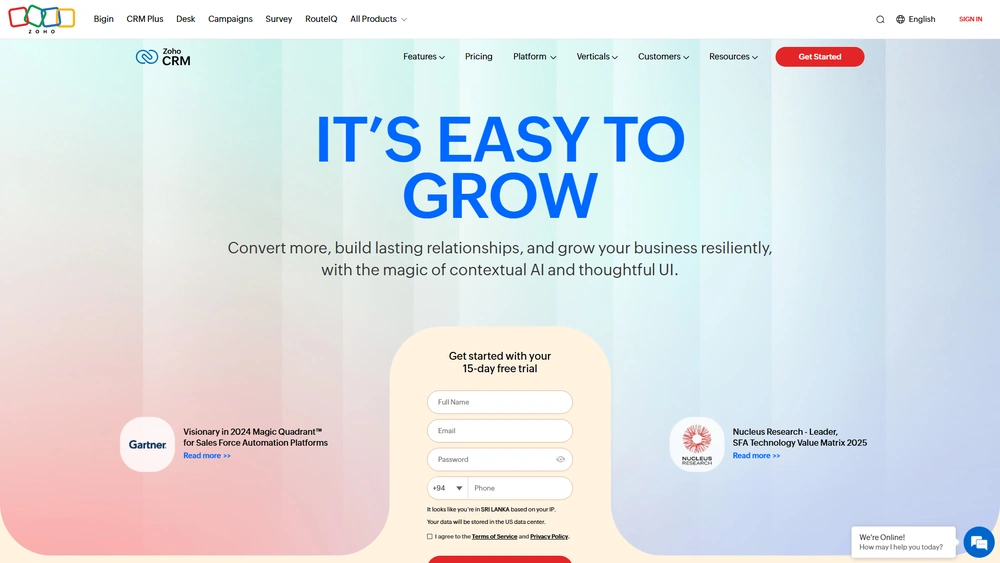Zoho CRM Overview & 2025 Industry Position
Zoho CRM has grown into a cornerstone of cloud-based customer relationship management, especially favored by small to midsize businesses seeking feature-rich flexibility at an affordable price. As of 2025, the platform rides at the forefront of AI-powered sales workflows, omnichannel engagement, and advanced automation. With over 250,000 global customers and deep integrations across its Zoho ecosystem and third-party tools, Zoho CRM positions itself as a smart, scalable CRM without enterprise bloat—or cost. In 2025, Zoho is solidifying its stand as the go-to adaptive CRM, ushering in performance-enhancing AI like Zia 3.0, no-code customization layers, and revamped mobile sales tools.
From Launch to 2025: Zoho CRM’s Journey
Founded in 2005 by Zoho Corporation, Zoho CRM started as a lightweight, affordable alternative to enterprise-grade CRMs. Over the years, it’s become a robust ecosystem, evolving across UX updates, automation expansions, and AI integrations.
Key Milestones:
- 2005: Launches as a simpler, cost-effective CRM.
- 2010: Debuts integrations with G Suite and Zoho Apps.
- 2016: Introduces Zia AI-driven sales assistant.
- 2018: Omnichannel features rolled out (chat, phone, social).
- 2023: Launch of Canvas for no-code UI customization.
- 2025: Expands Zia AI for predictive sales actions & real-time automation testing.
Zoho CRM’s 2025 strategy focuses on hyperpersonalized sales journeys, AI at every workflow tier, and seamless scalability for SMBs.

Zoho CRM Key Features
Zoho CRM brings a balanced mix of core CRM functionality and standout innovations. Its most valuable 2025 features include:
- Zia AI 3.0: Smarter lead scoring, email sentiment analysis, and automated task recommendations based on historical trends.
- Canvas UI: Completely no-code drag-and-drop UI editor for tailoring interfaces by role or team.
- Omnichannel Communication: Native support for telephony, SMS, email, social media, live chat, and web forms.
- CommandCenter: Workflow-level orchestration for multi-stage customer journeys.
- KPIs & Forecasting: AI-backed forecasting, real-time dashboards, and performance targets for teams.
- Mobile CRM: Redesigned in 2025 for field sales with geolocation tracking and on-the-fly reporting.
Workflow & UX
Zoho CRM excels in blending functional richness with UI flexibility. Its learning curve is softened by Canvas UI and guided onboarding. The interface is clean, customizable, and suits both sales teams and managerial roles. Users can create modules for custom objects, reorganize navigation layouts, and trigger context-based automations effortlessly. Mobile UX is a 2025 strong point, thanks to a fully rebuilt native app that supports offline syncing and field route suggestions.
Zoho CRM Pricing Analysis & Value Metrics
Zoho CRM offers tiered pricing aligned with team maturity and automation needs. All plans include mobile access, Zoho ecosystem integrations, and limited Zia AI features.
| Plan | Cost/User/Month (Billed Annually) | Key Features |
|---|---|---|
| Standard | $20 | Core CRM, Workflows, Scoring Rules, Dashboards |
| Professional | $35 | Omnichannel, Inventory, Blueprints |
| Enterprise | $50 | Zia AI, CommandCenter, Advanced Customization |
| Ultimate | $65 | Advanced BI w/ Zoho Analytics, Enhanced Storage, Sandbox |
Value Verdict: Zoho CRM stands out for including automation and AI at lower pricing tiers compared to Salesforce or HubSpot, especially suited for SMBs scaling operations.
Competitive Landscape
| CRM | Best For | Starting Price | Key Differentiator |
|---|---|---|---|
| Zoho CRM | SMBs needing automation | $20/mo | Full feature access at lower tiers |
| HubSpot | Startups/freelancers | Free (limited) | UX + marketing automation |
| Salesforce | Large/global firms | $25/mo | Enterprise extensibility |
| Pipedrive | Sales-first teams | $21/mo | Pipeline-centric UX |
Use Cases
Zoho CRM suits a wide array of industries, but shines most in:
- Real Estate: Smart contact segmentation, mobile updates from field visits.
- SaaS: Lifecycle management across freemium → paid flows.
- Agencies: Custom deal stages per client, task automation.
- eCommerce: Cart abandonment campaigns via omnichannel triggers.
Integrations & Ecosystem
Zoho CRM connects natively with over 600 third-party apps and seamlessly within the Zoho suite. Notables include:
- Zoho Books & Zoho Invoice: One-click client syncing and quote-to-cash flows.
- Google Workspace & Outlook: Calendar, Gmail sync, auto-logging events.
- Slack, Trello, Zoom: Remote sales management.
- Stripe, Paypal, Razorpay: Billing integrations.
Pros & Cons
- Pros: Excellent value, deep features at mid-tier pricing, full omnichannel CRM, mobile optimization, full Zoho ecosystem access.
- Cons: Slight learning curve in automation builder, support tier varies by plan, some UI elements still dated without Canvas.
Pro Tip: Use Canvas to build team-specific dashboards—sales reps see pipelines, while managers monitor KPIs and forecasts.
Final Thoughts
For SMBs and mid-market companies, Zoho CRM users get an AI-enhanced, fully customizable CRM without committing to enterprise prices. While initial setup takes some effort, the flexibility and automation depth repay quickly. With its advanced AI roadmap, refreshed mobile app, and unbeatable value, Zoho CRM is our top 2025 pick for scaling teams who want sales systems that adapt and grow.
Zoho CRM FAQ
Zoho CRM offers a free edition for up to 3 users with limited features. Most businesses upgrade to a paid tier for full functionality.
Yes. You can sync emails, contacts, calendars, and use Zoho’s Gmail plugin to manage CRM actions directly from your inbox.
Zia is Zoho CRM’s built-in AI assistant. In 2025, it handles forecasting, anomaly detection, workflow suggestions, and sentiment analysis across communications.
Yes. Zoho CRM includes workflow automation, Blueprints for sales processes, and CommandCenter for journey-based automations.
Highly. Users can create custom modules, update layouts, define roles, build custom buttons, and personalize the UI using the Canvas design feature.